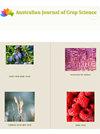Agronomic performance of maize under nitrogen fertilization and inoculation with Azospirillum brasilense
Q3 Agricultural and Biological Sciences
引用次数: 0
Abstract
Given the potential of Azospirillum brasilense as an alternative to improve availability and use of N by maize, it is critical to conduct research in different regions to assess the results of inoculation under several different conditions. The study aimed to analyse the influence of Azospirillum brasilense on the growth and maize yield, as well as its interaction with nitrogen (N) fertilization. The experiment was conducted in two trials (Palotina, PR – trial 1; Ariquemes, RO – trial 2) in Brazil. The experimental design was randomized blocks in a factorial 2x4 arrangement. First factor was application of N fertilization (with or without application), while the second factor consisted of A. brasilense inoculation such as: no inoculation (control), via seed treatment (ST), via leaf application (LA) and ST + LA. The N contents of leaf and the agronomic performance were assessed. Analysis of variance was conducted with the F test (p<0.01). The mean levels of the inoculation factor with A. brasilense were compared via Tukey’s test (p<0.01). The F-test was conclusive in comparing the means of the levels of N application factor. The analysis was conducted by means of orthogonal contrasts to compare the treatment of A. brasilense with those treated with N fertilization. In trial 1, the applying N fertilization associated to A. brasilense via ST and LA may contribute to increase yield. In trial 2, inoculation with A. brasilense seems to be a technology with good prospects for application, contributing to improve production conditions and increase maize yield. Inoculation with A. brasilense is important to supply N to plants, with an increase in agronomic performance of maize. However, inoculation with A. brasilense was not sufficient to meet the demand for N fertilization施氮和接种巴西固氮螺旋菌对玉米农艺性能的影响
鉴于巴西氮螺旋菌作为提高玉米氮素利用率和利用率的替代菌的潜力,在不同地区开展研究,评估不同条件下接种效果至关重要。本研究旨在分析巴西氮螺旋菌对玉米生长和产量的影响及其与氮肥的相互作用。试验分两个试验进行(Palotina, PR -试验1;巴西的RO试验2。试验设计采用2 × 4阶乘随机分组。第一个因素是施氮(施氮或不施氮),第二个因素是接种巴西螺,包括不接种(对照)、经种子处理(ST)、经叶片处理(LA)和ST + LA。对叶片氮含量和农艺性能进行了评价。方差分析采用F检验(p<0.01)。采用Tukey’s检验比较巴西螺接种因子的平均水平(p<0.01)。f检验在比较氮素施用因子水平均值方面具有结论性。采用正交对比的方法,对巴西螺处理与施氮处理进行了比较。在试验1中,通过ST和LA对巴西香薷施氮可能有助于提高产量。试验2表明,接种巴西芽孢杆菌是一项具有良好应用前景的技术,有助于改善玉米生产条件,提高玉米产量。接种巴西孢子虫对玉米的氮素供给具有重要意义,可提高玉米的农艺性能。然而,接种巴西孢子菌不足以满足对氮肥的需求
本文章由计算机程序翻译,如有差异,请以英文原文为准。
求助全文
约1分钟内获得全文
求助全文
来源期刊

Australian Journal of Crop Science
农林科学-农艺学
CiteScore
1.20
自引率
0.00%
发文量
75
审稿时长
3.5 months
期刊介绍:
Information not localized
 求助内容:
求助内容: 应助结果提醒方式:
应助结果提醒方式:


